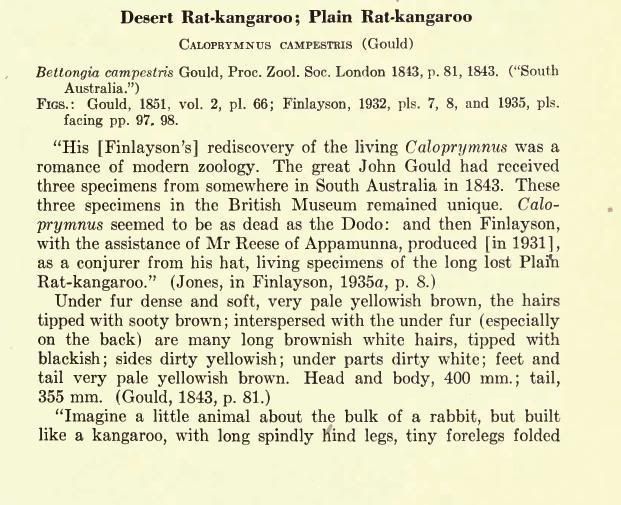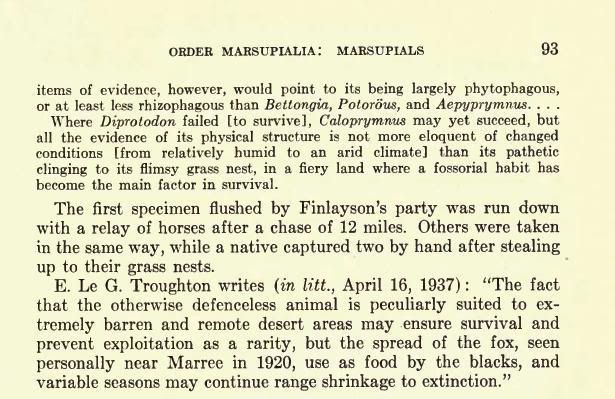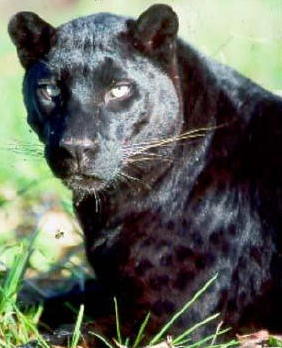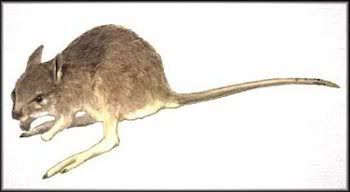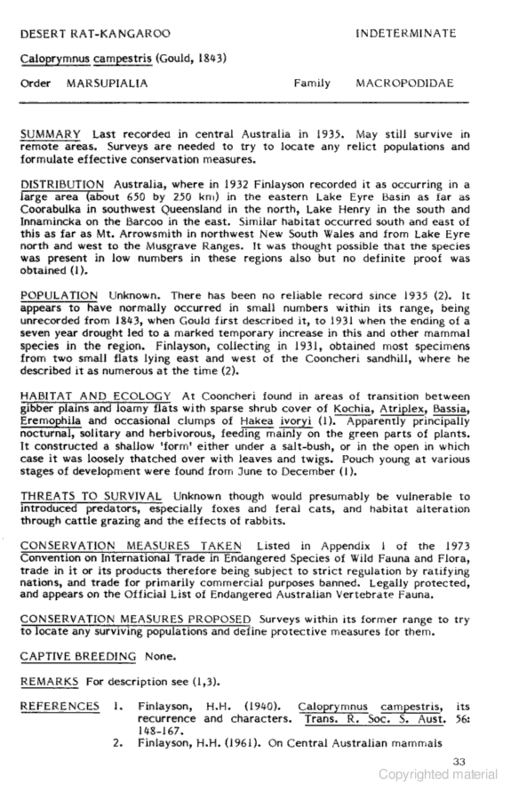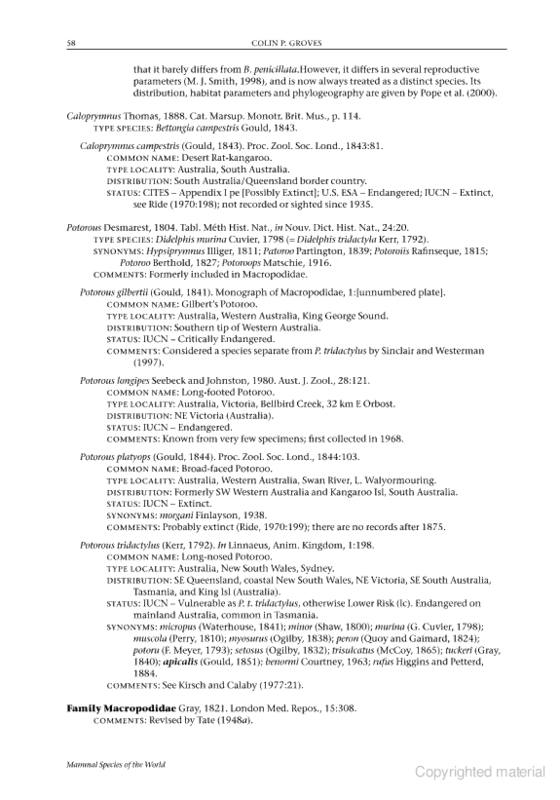|
|
Post by ada on Feb 18, 2006 12:32:33 GMT
 - Wikipedia quote. Lately I took more interest in Australia's extinct marsupials and I decided to take a closer look at species like the Caloprymnus campestris and I found a good site here: animaldiversity.ummz.umich.edu/site/accounts/information/Caloprymnus_campestris.htmlNow here comes the most interesting part, its a quote from the said site: This would certainly be quite a find! The Caloprymnus campestris was known to live in the largely unpopulated dry deserts of Australia, where the climate was too harsh for forein animals like cats or rabbits. If there is evidence that the Desert Rat Kangaroo didn't die in the 30s but was alive a few years ago, then there is great probablity that the population is still alive. Even if its just one more species of the Potoridae familly that managed to escape extinction, it still would be wonderful news. Does anyone have more information concerning that find and the final fate of the Desert Rat Kangaroo species?  |
|
|
|
Post by another specialist on Feb 18, 2006 15:35:55 GMT
Geographic Range Caloprymnus campestris is thought to occupy a relatively small area in Southern Australia, extending just over the borders of Queensland and Northern Territory. Although not spotted since 1935 (when it was seen in the Lake Eyre region of northern Southern Australia), apparently recent remains of C. campestris have been found in caves of southeastern Western Australia (Lavery, 1985). Habitat Caloprymnus campestris lives in an arid, desert region of Australia,including clay pans, sandridges and gibber plains. Cover is sparse and consists of saltbrush, cherropods and Emu bush (Nowak, 1992). Physical Description The coloring of the pelage of C. campestris is appropriate for its desert surroundings. A pale, yellowish, ochre on top blends C. campestris with clay soils; while ventral surfaces are lighter. The muzzle of C. campestris is short with large upper lips. Ears are very long and covered with fur. Neck glands have been observed in some specimens. A distinguishing feature of C. campestris is the difference in size between fore and hindlimbs. Forelimbs are quite delicate with bones weighing 1 gram, while hindlimbs are large with bones weighing 12 grams. This difference is related to saltation. Other characteristics related to hopping locomotion include the large difference in limb size, long tail, plantigrade hindfoot, and syndactyly. The 4th toe of the hindfoot is the longest and is extremely strong. Caloprymnus campestris has an anteriorly opening pouch with 4 teats. Dentition is another crucial distinguishing feature. Caloprymnus campestris exhibits diprotodonty. Incisors are large with the 2nd and 3rd incisors smaller and laterally placed. Dental formula is 3/1, 1-0/0, 2/2, 4/4 = 32-34. There's also a blade-like premolar used for cutting, located behind a diastema. Molars are thought to erupt spontaneously, in contrast with other macropodids, in which eruption is sequential (Ganslosser 1988, Myers 1997, Nowak 1991, Strahan 1995). Reproduction Caloprymnus campestris females reach sexual maturity at approximately 11 months, while males reach maturity about 2 months later. There is marked sexual dimorphism with females being larger. Females go through estrous at 3 week intervals and can mate throughout the year. Although able to mate all year, Caloprynmus has an irregular breeding season when most mating takes place. Females with pouched joeys have been found between June and December. Young are born very undeveloped, as is typical of marsupials. Gestation is probably around 1-2 months, with a pouch period of 2-3 months. All females were found with only 1 young at a time. Young remain dependent for over 1 month after leaving the pouch and soon after leave permanently. Note: Due to indeterminate status (see Conservation and Biodiversity section), some reproductive characters were determined by comparing C. campestris to the Rufous Rat kangaroos and other "rat" kangaroos, rather than by direct observation (Ganslosser, 1988). Behavior Caloprymnus campestris is solitary except for young offspring with mothers. It lives in nests built over shallow depressions in the ground. Nests are excavated or found and are crucial in the desert, where there is relatively little brush or foliage to find cover under. The "pits" are lined with grass, which females carry to the nest with their tails. The nest is then covered with twigs. Caloprymnus spends most of the day taking shelter from the desert sun in its simple nest. Oftentimes, C. campestris is found peeking out of the top of the nest to observe its surroundings. Caloprymnus campestris has a distinct method of hopping. Its posture is forward and the 297-399mm tail is extended when it moves at high speeds, . Jumping is restricted to the back legs. Unlike other species, Caloprymnus lands with the right foot in front of the left foot. Caloprymnus campestris can move at full speed for as long as 20km. When moving at low speeds, C. campestris is pentapodal and moves like a rabbit (Strahan, 1995). Food Habits Caloprymnus campestris is mainly herbivorous but has been found to eat insects such as beetles and weevils. Calprymnus campestris nocturnally feeds on foliage and stems of vegetation. As a desert inhabitant, C. campestris is able to exist without surface water while feeding on green plants (Strahan, 1995). Economic Importance for Humans: Positive Australian aborigines used to capture C. campestris, possibly for food. Besides that, C. campestris has no other known economic importance (Lavery, 1985). Conservation Status Listed as indeterminate by the IUCN, and endangered by the USDI; C. campestris was last reported in 1935. It may be extinct, or it may be present in very small populations, waiting for conditions such as drought in which to make a comeback. No thorough efforts have been made to determine its status. Possible reasons for its decline and disappearance are the introduction of predators such as the fox and cat; competitors such as the rabbit; and the clearing of land for cattle grazing (Jenkins and Thornback, 1982). Other Comments The latin meaning of Caloprymnus is "beautiful rump," probably alluding to its beauty and powerful hind legs. Campestris means "plain, level country," referring to its habitat. Besides being called the desert rat kangaroo, C. campestris is also called the plains rat kangaroo (Strahan, 1995). Contributors Lindsay DuVall (author), University of Michigan: June, 1999. References Ganslosser, U. 1988. Grizimek's Encyclopedia. McGraw-Hill Publishing, New York. Vol 1. pgs. 35-39. Jenkins, M. and Thornback, J. 1982. The IUCN Mammal Red Data Book Part 1. IUCN Gland, Suiz. pgs. 33-34. Lavery. 1985. The Kangaroo Keepers. University of Queensland Press, Queensland. pgs. 46-48. Myers, P. 1997. Animal Diversity Web. www.oit.itd.umich.edu/projects/ADW/Nowak, R.M. 1991. Walker's Mammals of the World. Johns Hopkins University Press, Baltimore. Vol 1. pgs. 10-12, 90-91. Strahan, R. 1983. The Australian Museum Complete Book of Australian Mammals. Angus and Robertson Publishers. pgs. 177-178, 192. Strahan, R. 1995. The Mammals of Australia. Reed Books, Australia. pgs. 296-297. animaldiversity.ummz.umich.edu/site/accounts/information/Caloprymnus_campestris.htmlThe full text from the site mentioned above so everyone can have a easy read |
|
|
|
Post by ada on Feb 18, 2006 17:37:19 GMT
Thanks, I wasn't sure if quoting entire articles from other sites is forbidden here or not.
Anyways, what do you personally think: Is there a chance that this species is alive and if yes then how large is this possibility?
|
|
|
|
Post by another specialist on Feb 19, 2006 9:37:33 GMT
Well there is always a possibility that an supposedly extinct species will be found just like the rediscovery of the Gilbert Potoroo. We will just have to wait and fingers crossed.
|
|
|
|
Post by another specialist on Dec 5, 2006 11:17:39 GMT
stuffed specimen of the Desert Rat Kangaroo (from Walker's Mammals of the World)  |
|
|
|
Post by another specialist on Dec 5, 2006 11:22:31 GMT
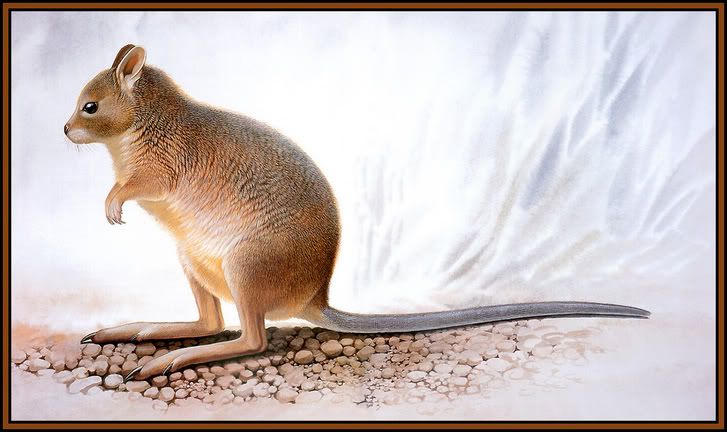 desert rat kangaroo gap in nature |
|
|
|
Post by another specialist on Dec 5, 2006 11:26:33 GMT
The Desert Rat-Kangaroo (Caloprymnus campestris) lived in the driest, hottest and most desolate environments in Central Australia. It was the size of a small rabbit. It was graceful, scarcely seeming to touch the ground as it hopped, almost floating, effortlessly, through the air. It showed great endurance and 'paused only to die'. It sheltered in a flimsy nest by day. At night, it emerged to feed. It lived alone and was so independent of water, that it even shunned the succulent plants of the sandhills. It was first recorded by Europeans around 1841 and was not seen again for 90 years. The last sighting was in 1935. en.wikipedia.org/wiki/Caloprymnus_campestris |
|
|
|
Post by another specialist on Jan 30, 2007 7:28:55 GMT
BUFF-NOSED RAT-KANGAROO Caloprymnus campestris Caloprymnus campestris was endemic to Australia. There have been no reliable records of the species since 1935. The desert rat-kangaroo was found on gibber plains, clay pans and sandridges. Hunting, direct habitat alteration by man, and introduced predators have all contributed to the extinction of this species. |
|
|
|
Post by another specialist on Jan 30, 2007 7:29:20 GMT
|
|
|
|
Post by another specialist on Jan 30, 2007 7:29:42 GMT
BUFF-NOSED RAT-KANGAROO Caloprymnus campestris also known as desert rat kangaroo |
|
|
|
Post by another specialist on Jan 30, 2007 7:30:10 GMT
BUFF-NOSED RAT-KANGAROO Caloprymnus campestris or Desert rat kangaroo It is a small, sandy furred species of hopping marsupial, characterised by its long ears, naked muzzle and enormous hind feet. It was first made known to science in 1843, when 3 specimens were collected from an unknown locality in South Australia by Sir George Gray, who sent them to the British Museum of Natual History. Nothing more was heard of it until the aerly 1930's, when it was rediscovered by Adelaide University Zoologist Dr. H.H. Finlayson, who recorded in September 1931 that he had sighted a number of specimens in a large expanse of plains country within Lake Eyre Basin, straddling the borders of south Australia and Queensland. Since then, however, no additional, conclusive observations have been reported, so that many fear that this scarcely known marsupial, the only member of its genus, is extinct. The Lost Ark Dr Karl Shuker |
|
|
|
Post by another specialist on Sept 10, 2007 14:09:33 GMT
Desert Rat Kangaroo;Caloprymnus campestris Geographic Range Caloprymnus campestris is thought to occupy a relatively small area in Southern Australia, extending just over the borders of Queensland and Northern Territory. Although not spotted since 1935 (when it was seen in the Lake Eyre region of northern Southern Australia), apparently recent remains of C. campestris have been found in caves of southeastern Western Australia (Lavery, 1985). Habitat Caloprymnus campestris lives in an arid, desert region of Australia,including clay pans, sandridges and gibber plains. Cover is sparse and consists of saltbrush, cherropods and Emu bush (Nowak, 1992). Physical Description The coloring of the pelage of C. campestris is appropriate for its desert surroundings. A pale, yellowish, ochre on top blends C. campestris with clay soils; while ventral surfaces are lighter. The muzzle of C. campestris is short with large upper lips. Ears are very long and covered with fur. Neck glands have been observed in some specimens. A distinguishing feature of C. campestris is the difference in size between fore and hindlimbs. Forelimbs are quite delicate with bones weighing 1 gram, while hindlimbs are large with bones weighing 12 grams. This difference is related to saltation. Other characteristics related to hopping locomotion include the large difference in limb size, long tail, plantigrade hindfoot, and syndactyly. The 4th toe of the hindfoot is the longest and is extremely strong. Caloprymnus campestris has an anteriorly opening pouch with 4 teats. Dentition is another crucial distinguishing feature. Caloprymnus campestris exhibits diprotodonty. Incisors are large with the 2nd and 3rd incisors smaller and laterally placed. Dental formula is 3/1, 1-0/0, 2/2, 4/4 = 32-34. There's also a blade-like premolar used for cutting, located behind a diastema. Molars are thought to erupt spontaneously, in contrast with other macropodids, in which eruption is sequential (Ganslosser 1988, Myers 1997, Nowak 1991, Strahan 1995). Reproduction Caloprymnus campestris females reach sexual maturity at approximately 11 months, while males reach maturity about 2 months later. There is marked sexual dimorphism with females being larger. Females go through estrous at 3 week intervals and can mate throughout the year. Although able to mate all year, Caloprynmus has an irregular breeding season when most mating takes place. Females with pouched joeys have been found between June and December. Young are born very undeveloped, as is typical of marsupials. Gestation is probably around 1-2 months, with a pouch period of 2-3 months. All females were found with only 1 young at a time. Young remain dependent for over 1 month after leaving the pouch and soon after leave permanently. Note: Due to indeterminate status (see Conservation and Biodiversity section), some reproductive characters were determined by comparing C. campestris to the Rufous Rat kangaroos and other "rat" kangaroos, rather than by direct observation (Ganslosser, 1988). Behavior Caloprymnus campestris is solitary except for young offspring with mothers. It lives in nests built over shallow depressions in the ground. Nests are excavated or found and are crucial in the desert, where there is relatively little brush or foliage to find cover under. The "pits" are lined with grass, which females carry to the nest with their tails. The nest is then covered with twigs. Caloprymnus spends most of the day taking shelter from the desert sun in its simple nest. Oftentimes, C. campestris is found peeking out of the top of the nest to observe its surroundings. Caloprymnus campestris has a distinct method of hopping. Its posture is forward and the 297-399mm tail is extended when it moves at high speeds, . Jumping is restricted to the back legs. Unlike other species, Caloprymnus lands with the right foot in front of the left foot. Caloprymnus campestris can move at full speed for as long as 20km. When moving at low speeds, C. campestris is pentapodal and moves like a rabbit (Strahan, 1995). Food Habits Caloprymnus campestris is mainly herbivorous but has been found to eat insects such as beetles and weevils. Calprymnus campestris nocturnally feeds on foliage and stems of vegetation. As a desert inhabitant, C. campestris is able to exist without surface water while feeding on green plants (Strahan, 1995). www.ppne.co.uk/index.php?m=show&id=14549 |
|
|
|
Post by another specialist on Sept 10, 2007 19:10:24 GMT
Desert Rat Kangaroo (Caloprymnus campestris) 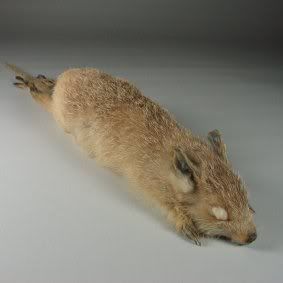 Desert Rat Kangaroo Skin Study skin of a Desert Rat-kangaroo (Caloprymnus campestris): an example of the rare mammal specimens exchanged with other museums during the Museum’s early years. This species is now thought to be extinct. South Australia’s Governor, George Grey, sent specimens to the British Museum during the early 1840s. The Desert Rat-kangaroo was not sighted again until 1931, when this specimen was collected at Cooncherie, Diamantina River, S.A., by the Museum’s Honorary Curator of Mammals, H.H. Finlayson. Only five specimens are known. M3257. s121.photobucket.com/albums/o224/godino33/extinct%201/ |
|
|
|
Post by another specialist on Sept 10, 2007 19:17:53 GMT
|
|
|
|
Post by Bhagatí on Nov 20, 2007 20:39:21 GMT
|
|
|
|
Post by ada on Dec 1, 2007 22:46:19 GMT
Thanks for the new info. Though it most probably been killed off by cats and foxes, I still hope that the species is not extinct and escaped into the deep desert where the foxes and cats were unable to follow.
|
|
|
|
Post by another specialist on Dec 20, 2007 12:46:08 GMT
|
|
|
|
Post by another specialist on Jan 5, 2008 17:34:51 GMT
|
|
|
|
Post by another specialist on Jan 6, 2008 21:34:51 GMT
|
|
|
|
Post by another specialist on May 28, 2008 15:02:05 GMT
|
|









